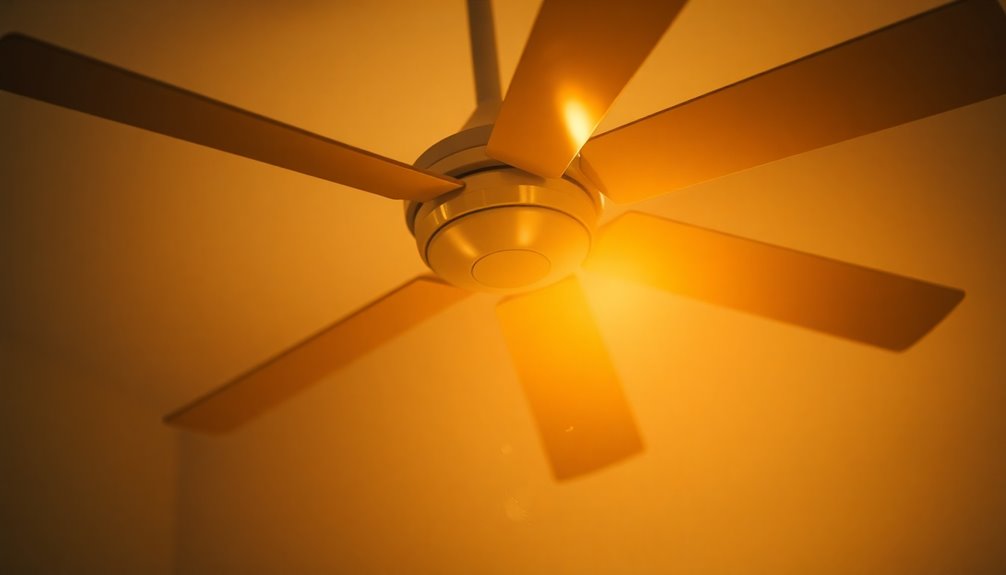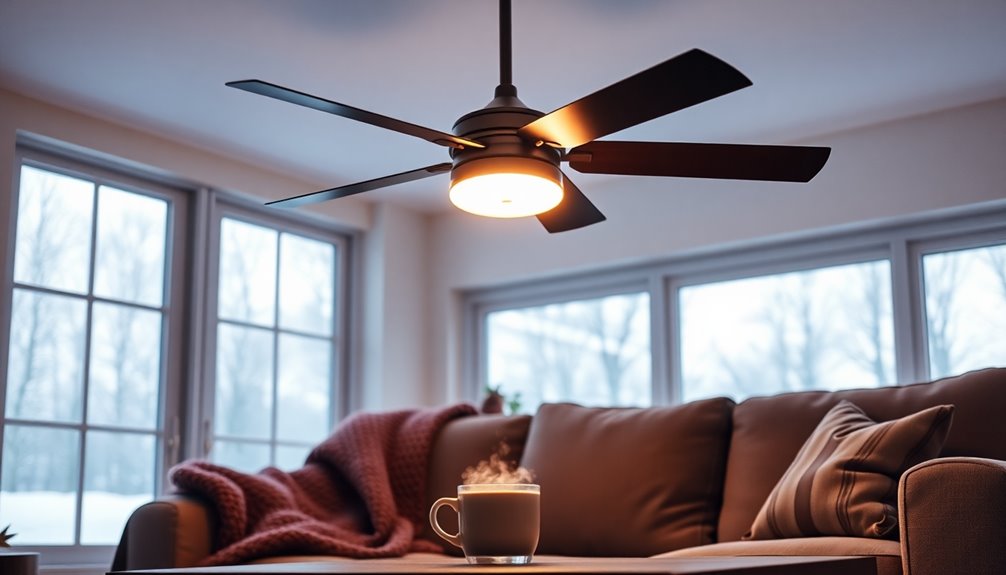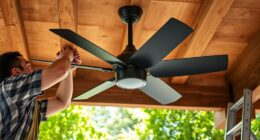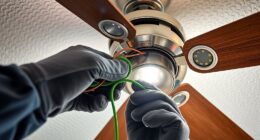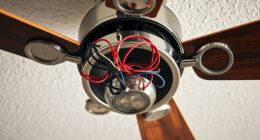Ceiling fans wobble because of imbalances created by uneven blade lengths, loose screws, or dust accumulation. When blades aren't securely attached or are warped from humidity, it disrupts the fan's rotation. If you notice wobbling, check that all screws are tight and clean off any dust. Sometimes, using a blade balancing kit can help you distribute weight evenly. Additionally, the quality of your fan matters; high-quality models are designed to minimize wobble. Keeping up with maintenance will also reduce issues. Keep exploring to uncover more tips on how to keep your ceiling fan steady and running smoothly.
Key Takeaways
- Ceiling fans wobble due to imbalances from uneven blade lengths or misalignment affecting smooth rotation.
- Loose screws on blade attachments can lead to significant instability and wobbling during operation.
- Dust accumulation on blades creates weight imbalances, disrupting the fan's equilibrium and causing wobbling.
- Warped blades from humidity or temperature fluctuations can impair balance and contribute to wobbling.
- Improper installation, such as using non-fan rated ceiling boxes, increases the risk of fan wobbling.
Causes of Ceiling Fan Wobbling

Ceiling fan wobbling can be frustrating, and understanding its causes is the first step to resolving the issue. One common reason for a wobbly ceiling fan is an imbalance created by uneven blade lengths or misaligned blades. When the blades don't sit correctly, they can disrupt the fan's rotation.
In addition, loose screws securing the blades to the motor can contribute notably to the wobbling. Over time, normal wear and tear can loosen these screws, making it crucial to check their tightness regularly.
Another factor to take into account is dust accumulation on the fan blades. Dust can create a weight imbalance, leading to wobbling during operation.
Moreover, warped blades are often the result of environmental changes, such as humidity or temperature fluctuations. These warped blades can disrupt the fan's equilibrium and exacerbate the wobbling issue.
Finally, improper installation, such as using a non-fan rated ceiling box, can lead to instability, making your ceiling fan wobble even more.
Fixing Blade Alignment

To fix blade alignment, start by confirming all blades are securely attached to their holders and that the screws fastening the blade holders to the fan flywheel are tightly fastened.
Loose screws can lead to a wobbly fan, so double-check this step first.
Next, grab a yardstick to measure the distance between each blade and the ceiling. You want to verify uniformity for proper alignment.
If you notice any discrepancies, gently bend the blade holder to adjust the angle of the blades until they're even.
Once you've made the necessary adjustments, run the fan at high speed to check for any continued wobble.
This test is vital to confirm the blades are operating smoothly and that you've achieved proper blade alignment.
Using a Blade Balancing Kit

If you've noticed your fan wobbling despite fixing the blade alignment, a blade balancing kit can be a game changer. This kit typically includes plastic clips and adhesive weights designed to help you adjust the weight distribution on your fan blades, effectively correcting those annoying wobbling issues.
Start by running your ceiling fan at a moderate speed. Attach a plastic clip to the end of one of the fan blades; this helps you identify which blade is causing the wobble. Once you pinpoint the problematic blade, you can adjust the clip's position or replace it with adhesive weights. Your goal is to minimize or eliminate the wobbling.
After each adjustment, be sure to test the fan at high speed. This guarantees you've effectively resolved the wobble.
Regular use of a blade balancing kit not only helps maintain your ceiling fan's stability and performance, but it also extends its lifespan and reduces noise. By taking these simple steps, you'll enjoy a smoother, quieter fan experience, making your living space more comfortable.
Don't let a little wobble disrupt your peace!
Quality of Ceiling Fans

When you invest in a quality ceiling fan, you're not just buying a cooling appliance; you're ensuring a smoother, quieter operation that enhances your comfort. High-quality ceiling fans are engineered with precision, which minimizes wobbling issues thanks to better blade balance and alignment during manufacturing. When you choose reputable brands, you often benefit from durable materials that resist warping, further reducing the likelihood of wobbling over time. Additionally, necessary cookies are utilized to enhance the overall user experience on websites, ensuring that you can gather all relevant information before making your purchase. Regular maintenance can also help identify mechanical failure early, preventing wobbling before it becomes a significant issue. Investing in a best air flow ceiling fan can significantly improve airflow and reduce wobbling caused by uneven air distribution. Moreover, quality ceiling fans typically feature advanced motor technology that operates more smoothly, decreasing the chances of wobbling at various speeds. For instance, some models incorporate energy-efficient options that not only save on utility bills but also contribute to a more stable operation.
If you're considering a fan for a larger space, look for models with integrated balancing systems designed to account for airflow and room dimensions. These features greatly lower the risk of wobbling. Additionally, higher-quality fans often come with warranties that cover manufacturing defects, giving you peace of mind against potential wobbling caused by inferior craftsmanship. Investing in a quality ceiling fan is similar to choosing the best home security systems that offer enhanced reliability and peace of mind. By investing in a quality ceiling fan, you're not just enhancing your environment; you're also choosing longevity and reliability that keep discomfort at bay.
Maintenance and Care

Even with a quality ceiling fan, regular maintenance and care are vital to guarantee its best performance and longevity.
Start by dusting the fan blades regularly to prevent dust buildup, which can lead to imbalance and wobbling over time. It's also important to periodically check the alignment of the blades and the tightness of the screws. These simple tasks help maintain peak fan performance and stability.
If you notice persistent wobbling, consider using a blade balancing kit. This tool can effectively adjust the weight distribution of the fan blades, resolving most wobbling issues.
Remember, proper installation is equally important. Make sure that the mounting bracket is secure, as this greatly contributes to the fan's longevity.
Keep an eye out for signs of wear and tear, like loose hardware or warped blades. Addressing these issues promptly allows for early intervention, preventing more serious wobbling problems down the line.
Frequently Asked Questions
How Can I Stop My Ceiling Fan From Wobbling?
To stop your ceiling fan from wobbling, first, check that all screws holding the blades and mounting bracket are tightly secured.
Next, use a tape measure to verify uniform spacing between each blade and the ceiling.
Clean the blades regularly to remove dust, which can cause imbalance.
If wobbling persists, use a ceiling fan balancing kit to adjust the weight distribution or inspect for warped blades.
Don't hesitate to seek professional help if needed.
Should I Be Worried About a Wobbly Fan?
Did you know that a ceiling fan can wobble up to 1 inch off-center? If your fan's wobbling, you should definitely pay attention.
While a slight wobble mightn't seem alarming, it can lead to bigger issues, like hardware loosening or even safety hazards.
Regular maintenance and cleaning are key to ensuring stability. If the wobbling continues after adjustments, you might want to call a professional to inspect it for deeper problems.
Will a Ceiling Fan Fall if It Wobbles?
If your ceiling fan wobbles, it doesn't always mean it'll fall, but it's a concern you shouldn't ignore.
Persistent wobbling may indicate improper installation or loose screws, which can increase the risk of the fan detaching.
To guarantee safety, you should regularly inspect and maintain your fan.
If the wobbling is severe, it's wise to address the issue promptly to prevent potential accidents or damage in your space.
Why Do Ceiling Fans Go Out of Balance?
Ceiling fans can go out of balance for several reasons.
You might notice that warped blades, often caused by humidity or temperature changes, disrupt their shape. Loose screws securing the blades or the mounting system can also lead to instability.
If dust accumulates unevenly or blade lengths are inconsistent, it adds to the imbalance.
Regular maintenance, like cleaning and tightening screws, helps keep your fan running smoothly and prevents these issues from arising.
Conclusion
In the dance of your ceiling fan, a wobble can feel like an offbeat note in a beautiful melody. By correcting blade alignment and ensuring proper maintenance, you can restore harmony to your space. Just like a well-tuned instrument, a balanced fan enhances your home's rhythm. So, take the time to nurture your ceiling fan, and watch it spin gracefully, creating a soothing breeze that wraps you in comfort, turning your room into a serene oasis.




